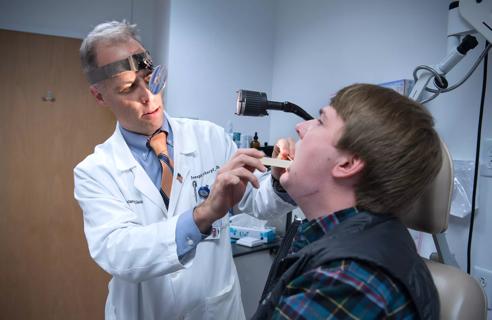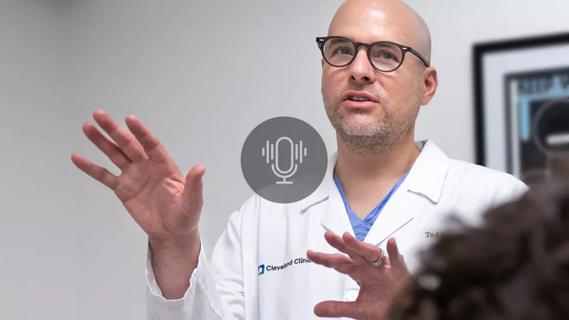Because EILO is a relatively new condition, educating care providers to help diagnose and treat earlier is critical

Exercise has many health benefits, but sometimes it can cause breathing problems, especially in younger athletes. Conditions such as exercise-induced asthma, exercise-induced bronchoconstriction (EIB) and breathing pattern disorder (BPD) can greatly impact performance and breathing. Another condition, exercise-induced laryngeal obstruction (EILO), also known as vocal cord dysfunction (VCD), is a functional extra-thoracic cause of breathing difficulty that affects the glottic and supraglottic structures causing breathing problems during exercise.
Advertisement
Cleveland Clinic is a non-profit academic medical center. Advertising on our site helps support our mission. We do not endorse non-Cleveland Clinic products or services. Policy
Affecting up to one-third of athletes and 7% of adolescents (particularly females), EILO symptoms include shortness of breath, cough, stridor/wheezing, throat tightness, chest tightness/pain, anxiety and dysphonia. “Since EILO is a relatively new condition, we don’t yet understand its causes and why some people develop it. My research has found that 85% of EILO patients also have a breathing pattern disorder with tightness in the muscles of the abdomen, chest, neck and shoulders that restricts how you breathe,” says Claudio F. Milstein, PhD, CCC-SLP, a speech scientist at Cleveland Clinic Head and Neck Institute with clinical interests in laryngology and voice disorders. He is co-author of a paper on dysfunctional breathing in athletes which appears on the American College of Cardiology website.
With nonspecific symptoms unrelated to the pulmonary system, EILO is hard to diagnose and often misdiagnosed. “When patients see their primary care physician, they are often diagnosed with exercise-induced asthma and prescribed an inhaled bronchodilator which isn’t effective,” says Dr. Milstein. “They are then referred to a pulmonologist or allergist. If they experience chest pain, they need to see a sports cardiologist to rule out any cardiac conditions, even though it is rare in young patients. If basic tests don’t reveal what is wrong, they may be referred to a speech-language pathologist (SLP). We work with different specialists to rule out other conditions that could be causing the symptoms,” says Dr. Milstein.
Advertisement
Because EILO is not well-known, it can take a long time to be diagnosed. “Patients go from specialist to specialist, so it is critical to educate healthcare professionals and the public about EILO to help identify it and treat patients earlier,” says Dr. Milstein
EILO is diagnosed using a continuous laryngoscopy during exercise. The SLP or other healthcare provider uses a laryngoscope to look at the patient’s vocal cords and see if the airway narrows at or above the level of the vocal cords. “Laryngoscopy is the gold standard for diagnosing EILO. We can see if the voice box is obstructed or not and assess the breathing pattern when they are breathing heavily,” says Dr. Milstein.
To diagnose whether patients have both EILO and BPD, Dr. Milstein has developed a tool to identify and quantify BPD, which is characterized by a poor or inefficient breathing pattern resulting in breathlessness. The assessment tool, named the Milstein Breathing Pattern Disorder Assessment Index (M-BPDAI), can identify and score the degree of tightness in the abdomen, chest, shoulders and neck muscles during heavy breathing tasks.
Dr. Millstein recently published a study in Journal of Voice indicating strong potential for the M-BPDAI tool. The prospective study included 77 patients who were referred to Cleveland Clinic with suspected EILO, and a control group of 58 patients without any suspected respiratory difficulty. Both groups were evaluated using the M-BPDAI tool, and the M-BPAI score was significantly larger in the referred group compared to the control group. Using Youden Index, the authors determined the best cut-off for BPD diagnosis using the M-BPAI scale would be an overall score of ≥ 8. A total of 60 (78%) patients had an overall M-BPAI score of ≥ 8, which suggested that a large percentage of the 78 patients referred to the clinic for suspected EILO did indeed have BPD.
Advertisement
EILO responds well to respiratory and laryngeal control therapy provided by a speech-language pathologist (SLP). Treatment can include various approaches that are tailored to the patient’s individual needs. In an average of three to four sessions, patients learn breathing techniques to help open their airway and relax the throat, neck and shoulders while exercising. “We teach patients to retrain their respiratory system, breathe more efficiently and control the muscles of the voice box so they don’t tighten and narrow the airway during exercise,” says Dr. Milstein.
The sessions are generally spaced two weeks apart so patients can practice this new way of breathing until it becomes second nature. “It takes a lot of repetition and practice to change a habit,” says Dr. Milstein.
Dr. Milstein and colleagues are planning to continue research to expand use of M-BPDAI to diagnose other breathing disorders.
Advertisement
Advertisement

A deep dive into the evolution of surgical sleep therapy

A commitment to sharing expertise has fostered a global exchange of ideas

How a new clinic is helping to streamline evaluations for patients

A multidisciplinary approach and individualized plan of care are imperative

Insight on larynx disorders and treatments

Novel procedures provide options for patients who can’t tolerate CPAP

Research on children with UHL explores the quality-of-life benefits and outcomes of cochlear implants

A look at how custom-fitted oral appliances work and when they’re a good fit for patients